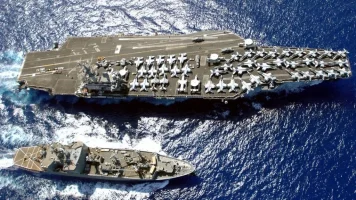- Views: 3K
- Replies: 20

The Indian military's pursuit of a reliable Medium Altitude Long Endurance (MALE) Unmanned Aerial Vehicle (UAV) has taken a new turn as the Adani Drishti 10, initially procured for testing, appears to be falling short of expectations, particularly for the Indian Army.
This development comes as both the Army and Navy are gearing up to issue a tender for the procurement of 76 MALE UAVs, signaling a shift towards dedicated platforms that can fulfill their specific operational requirements.
The Drishti 10, a locally manufactured version of Israel's Hermes 900, was acquired by the Army and Navy as an interim solution due to delays in the larger MALE UAV procurement program. The aim was to assess its suitability while awaiting a more comprehensive procurement initiative.
However, sources reveal that the Drishti 10's performance in high-altitude operations, crucial for the Army's deployments in challenging terrains like the Himalayas, has been less than satisfactory.
While the Navy has found the Drishti 10 to be adequate for its maritime surveillance needs, where altitude is less critical, the Army's need for a UAV capable of operating effectively in the high-altitude environment of the northern borders remains unmet. This disparity in performance requirements has led both services to prioritize the acquisition of dedicated MALE UAVs through a fresh tender.
The upcoming tender, seeking 60 units for the Army, 12 for the Air Force, and 4 for the Navy, is expected to attract bids from several global manufacturers. In line with the government's "Make in India" initiative, all contenders will be required to ensure local manufacturing within India.
This move is expected to boost the indigenous defence industry, with companies vying to participate by either collaborating with foreign technology providers or offering domestically developed platforms.
The procurement of these MALE UAVs is crucial for bolstering India's unmanned aerial capabilities and will play a significant role in reconnaissance, surveillance, target acquisition, and intelligence gathering. While the Drishti 10 served as a temporary measure, its mixed performance has highlighted the need for specialized platforms tailored to the specific needs of each service.
This situation also underscores the growing importance of indigenous defence manufacturing. As India seeks to reduce its reliance on imports and develop critical technologies domestically, the MALE UAV program presents a significant opportunity for the Indian defene industry to showcase its capabilities and contribute to the nation's self-reliance in defence technology.
Although the future of the Drishti 10 in the Indian military remains uncertain, particularly with the Army, the Navy's relative satisfaction with its performance might still lead to limited follow-up orders. The focus, however, is clearly on the upcoming MALE UAV tender, which promises to be a pivotal step in shaping India's future unmanned aerial capabilities.

